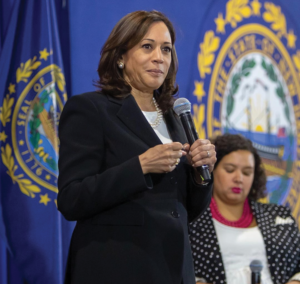On Feb. 5, 2019, the floor of the U.S. House of Representatives was a sea of white; white jackets on white slacks on white blouses as far as the eye could see. The record number of newly elected Democratic women were using fashion to make a statement during President Donald Trump’s State of the Union Address to honor the women’s suffrage movement, which often used white as a symbolic color.
Coverage of women in politics can focus too much on appearances and likeability. And while critics are often right to call out pundits’ focus on appearance, politicians, especially women, also have the power to use fashion as a tool to amplify their beliefs and share their backgrounds with the public. When used and interpreted correctly, fashion can benefit and complexify female politicians, rather than merely saddle them with sexist stereotypes.
Bigger Closets, Bigger Statements

From the politics of former secretary of state and 2016 presidential candidate Hillary Clinton’s pantsuits to Democratic majority leader and the Speaker of the House Nancy Pelosi’s (D-Calif.) burnt orange Max Mara coat during an Oval Office showdown with Trump, women in politics have used their style choices to make a statement and spread their message. Pelosi’s coat sparked such intense public discussion that Max Mara decided to reissue the piece six years after it was originally sold.
Politicians will always benefit from a wider array of options when it comes to how they present themselves, according to Georgetown University government professor Lise Howard.
“Anyone in the public spotlight will be scrutinized about every decision, including fashion,” Howard wrote in an email to The Hoya. “It seems to me that women in politics actually have more leeway than men to dress in ways that make them feel authoritative, authentic and at ease. Men only have a choice between this or that dark suit.”
Women have used the entire color spectrum and a multitude of silhouettes to make an impression, but some men have been able to shirk the limits of their closets to make statements through their clothes, like 2020 presidential candidate Andrew Yang’s choice to forgo a tie or former Texas representative and 2020 presidential candidate Beto O’Rourke’s constant rolling up of the sleeves.
Even though many men find their options limited, they too can craft a brand for themselves that explains what kind of candidate they hope to be, according to Kate Bennett, CNN White House reporter who covers fashion in politics and the first lady of the United States.
“It would feel weird if Bernie Sanders put on a Hugo Boss suit with a slim-cut trouser and a skinny tie and a pocket square, right?” Bennett said. “So it works both ways, for men and women, I think.”
A plethora of options make fashion a more flexible and powerful medium through which to share a political message, according to Emilia Ferrara (COL ’10), who teaches a fashion journalism course at Georgetown and serves as editor-in-chief of Capitally, a Washington, D.C. fashion magazine.
“I do regard fashion as an imminent vehicle for strategy and excellence,” Ferrara said in an interview with The Hoya. “The more options in your arsenal, the more power you have.”

Dressing for a Global Spotlight
Personal style creates a visible, dynamic platform to share a politician’s cultural point of view with an international audience, making fashion a tool of diplomacy. Politicians and diplomats can wear clothes that draw attention to their personal cultures and represent their communities with pride, according to Howard.
Former Liberian President Ellen Johnson Sirleaf’s fashion choices, which shared traditional Liberian clothing with the world, perfectly exemplified this stylistic strategy, according to Howard.
“She is always elegant and confident, while demonstrating her commitment to Liberia by wearing Liberian fashions,” Howard wrote.
Wearing a silhouette found across West Africa, Johnson Sirleaf takes traditional garments like the gele, a tied headscarf, and revamps them for the modern era and shares them on an international stage, fashion historian Amber Butchart wrote in a Google Arts & Culture editorial feature.
When a record number of women were sworn into the House of Representatives on Jan. 3, 2019, a contrast between the Democratic and Republican sides of the chamber was apparent. While the Republican side of the chamber was largely filled with white men in dark suits, the Democratic side was a rainbow of colors, patterns and styles. The new wave of women in Congress, most of whom were Democrats, used their fashion choices to express their diversity.
Lawmakers like Rep. Rashida Tlaib (D-Mich.) and Rep. Deb Haaland (D-N.M.) wore clothes that honored and showcased their traditionally marginalized and therefore politicized personal backgrounds. Tlaib wore a Palestinian thobe, a traditional embroidered gown, in tribute to her mother. Haaland, one of the first two Native American women elected to Congress, wore traditional clothing, moccasins and jewelry from the Pueblo tribe, of which she is a member.
Former secretary of state Madeleine Albright used pins to send a message in diplomacy, according to Ferrara. After an Iraqi media outlet referred to her as an “unparalleled serpent,” she wore a snake pin on her next trip to Iraq in 1994.
“She picked a pin that was extraordinarily tied on a deep level to the situation she was in,” Ferrara said. “Her pins always had a remarkable point of relevancy.”
Albright’s pins became such an integral part of her diplomatic repertoire and messaging strategy that the Smithsonian Castle featured them in a 2010 exhibit titled “Read My Pins: The Madeleine Albright Collection.”
Regardless of the policies they represent, these fashion choices represent how women can use their clothing as a way to make a statement that transcends mere aesthetic value. Choosing what pin to wear to any given event helped amplify Albright’s own political stances in a subtle but powerful way, the former secretary of state said in an NPR interview in 2009.
“As it turned out, there were just a lot of occasions to either commemorate a particular event or to signal how I felt,” Albright said.
In foreign policy, as well as in Congress, leaders make strategic choices about fashion to serve their goals and further their countries’ agendas. To argue that these choices are somehow less important because they happen to take the form of clothing diminishes the importance of visuals in communication and the power of the ability to harness fashion as a storytelling medium.
Fashion Faux Pas
While women can benefit from the multitude of ways to express themselves and their cultures through their clothing, they also face more pressure and face severe sexist critiques.
Making bold fashion statements also can lead to criticism that centers the conversation solely around the visual appearance and gendered connotations of their clothes, according to Ferrara.
“The flip side of that issue is when people say, ‘Well, aren’t women always criticized for dressing too sexy or aren’t women always criticized for dressing, you know, too much like a little girl,’” Ferrara said.
Some female politicians may try to wear clothes that do not attract attention in order to bring attention back to their ideas, but this can bring criticism as well. Clinton’s style when she transitioned from being first lady to perfectly captured this phenomenon, according to Bennett.
“She was sort of ‘anti-fashion” fashion. She just assumed, like, if I wear this pretty standard-issue — although it might be Ralph Lauren, it might be a pretty high-end designer, — pretty standard issue suit, no one’s gonna be able to critique,” Bennett said. “She had to find clothes that made her sort of disappear in that sense.”
However, the think pieces and articles that major publications ran during Clinton’s 2016 presidential campaign examining her fashion choices prove that even trying to hide behind inconspicuous clothes would prove an unsuccessful media strategy.
Likewise, female politicians themselves may object to the relevance of their outfits, but clothes make important claims that cannot just go ignored in certain contexts, according to Bennett.
On a diplomatic trip to Kenya in 2018, First Lady Melania Trump wore a white pith helmet, a hat worn frequently by European explorers and a symbol of colonialism.
“I was the one in Egypt who asked her about her clothing scandal from the day before, where she had worn the pith helmet in Kenya and created a hubbub. The next day in Egypt she did a quick Q&A with the press, and I asked her about that and she looked and me and she said, ‘I wish people would focus on, you know, what I do and not what I wear,’” Bennett said. “I mean, I would love to do that, too, Melania, but no, I don’t think we can.”
Analyzing the role of fashion in women’s political careers requires nuance, but it carries value. Dismissing reflections on fashion choices ignores a valuable part of many politicians’ messages, according to Bennett.
“People who sort of dismiss politics and fashion or that kind of coverage, again, are overlooking a multibillion dollar industry and a really viable way that politicians can and probably should be using their looks, their fashion, their style, to send a message,” Bennett said.














AKS Clothings • Jan 14, 2021 at 4:36 am
Thanks for sharing the useful information.